Afrikaners Seek a New Homeland
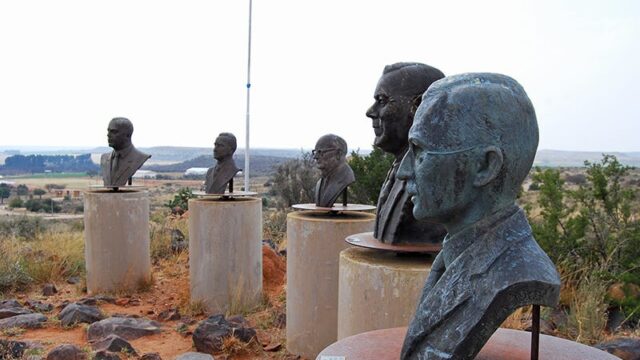
Foremost among the goals of Dan Roodt and others like him is to forge an authentic Afrikaner homeland, a place where the descendants of the historic “Boers” can feel safe and can be assured of their legitimate interests being protected.
Nearly everyone I speak with in Jo’burg and Pretoria said that they found the current state of things utterly untenable. Most fear creeping demographic disaster through massive emigration and low birthrates, continued economic disenfranchisement via relentlessly applied government-sponsored affirmative action and so-called land “reform,” and rising violence against their persons and property in the form of Black crime and terrorism.
Yet for all of the problems the 21st Century Afrikaner faces from without, his stubborn, individualistic streak hampers him from bonding with his kin and facing his enemies in a united front. An oft-heard, somewhat bitter joke I heard on several occasions from many sources, each independent of the others, runs thusly:
Q: What do you get when you put three Afrikaners on a desert island?
A: You get four different churches, and five different political parties.
Though there is much difference of opinion regarding which path to take out of the current quandary, there seems to be a general consensus that accepting the status quo indefinitely is a recipe for both individual and collective disaster, if not eventual ethnic extinction. Desperation hangs so thickly in the air that one can almost smell it. To many, it seems the future holds only the bleakest of prospects. Several hundreds of thousands of Afrikaners have emigrated from their home country to other places in the world since 1994—and even earlier, when the proverbial writing was on the wall that the Apartheid-era government was in its death throes.
Yet while many have left the country (and the continent) for such distant destinations as New Zealand, Australia, England, Canada, and the United States, and others have retreated within their heavily fortified homes behind barbed-wire fences and electric gates, hoping for the best while steeling themselves for the worst, a relatively small number of contemporary Afrikaners have opted to pursue a radical, risky, but potentially more rewarding course of action. Some, that is, have staked their hopes on the prospect of seceding from the current wreck of a “Rainbow Nation,” and constructing a kind of Boer ethno-state in its very midst, with the intention of reclaiming their genetic and cultural self-determination, and saving the Afrikaner identity from dilution and eventual extinction.
Currently, two such communities exist, though there is talk of more attempts to be launched in the near future.
KLEINFONTEIN
Kleinfontein is essentially a Pretoria suburb, located near “Diamond Hill,” the site of a legendary battle in the Anglo-Boer War. Orania, which has garnered much more national and international attention, can be found along an unassuming country road in the arid karoo of the Northern Cape. Both towns are 100 percent Afrikaner in ethnic composition, and the traditional Afrikaans language—an intriguingly uber-guttural tongue sometimes described as “bastard Dutch”—is proudly spoken and fiercely promoted.
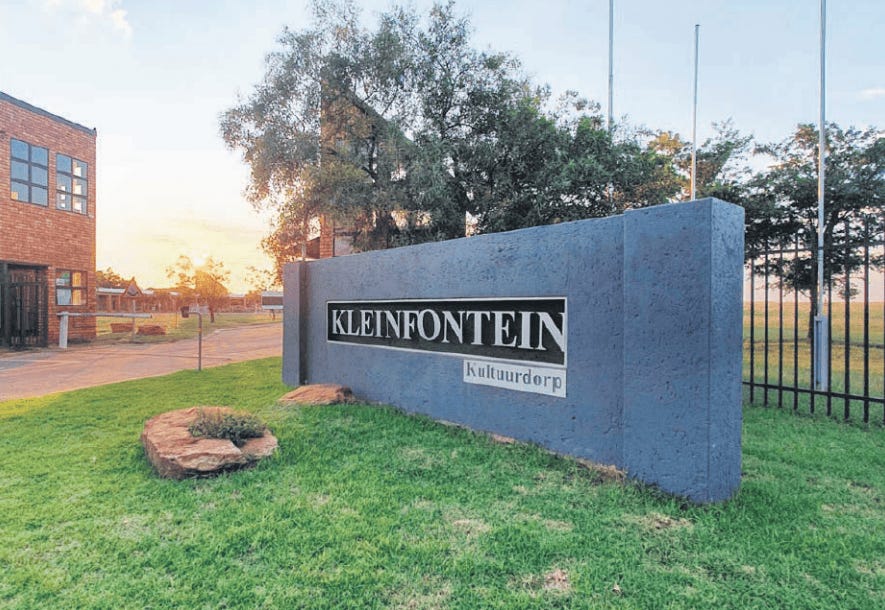
The short-term game plan of both Kleinfontein and Orania, of course, is to peacefully coexist with the South African governmental powers-that-be, not to brashly declare themselves inheritors of a new nation, as if spoiling for a fight. One gathers, however, that the leaders of both communities are keeping a sharp eye on social and political trends and measuring their prospects for political independence in the near future, should present cultural deterioration continue apace.
Needless to say, the greater the peril that Afrikaners feel themselves to be facing in their day-to-day lives, the more attractive such radical living options will start to appear, and the more Afrikaners flock to places like Kleinfontein and Orania, the harder it will be for such communities to avoid being seen as dangerously insubordinate hotbeds of rebellion against good “Rainbow Nation” values. For now, however, both towns are basically left alone.
Kleinfontein is a fascinating and impressively-conceived, if dusty and somewhat hardscrabble little place, full of winding dirt roads and rambling country houses, protected by a pair of guards and a checkpoint at the entrance. A statue of Hendrik Verwoerd—former South African prime minister and fervent Apartheid organizer and promoter—stands at the center of the town square.
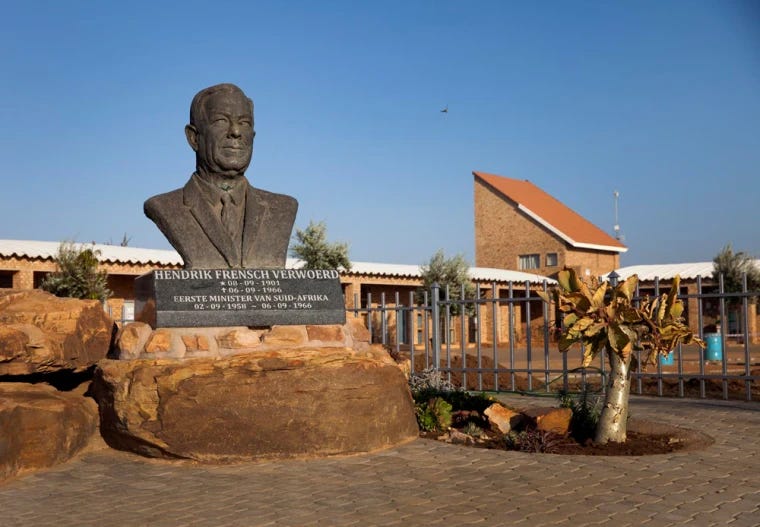
Verwoerd, who was brutally stabbed to death by a crazed Coloured man in the House of Assembly in Cape Town back in 1966, is an object of veneration to residents of both Kleinfontein and Orania, though both communities heavily reject the man’s policy of mandating racial segregation by law, if for no other reason than that it wound up making the Afrikaner spoiled and “soft,” reliant on other ethnicities to cook his food, clean his house, tend his garden, and otherwise perform his menial tasks.
The insistence that the Boer people need to relearn self-reliance was a constant refrain, one I heard emphasized by nearly everyone. One particularly mordant joke manages to reference both the fear of Black crime and apprehension that the modern-day Boer has lost the hardy, self-sufficient will that so characterized his intrepid Voortrekker ancestors:
Q: Who is an Afrikaner today?
A: Someone who’d rather get murdered in his bed than make it himself.
Kleinfontein’s founders hold that Gauteng is the most opportune province in which to establish a new Boer homeland, as the greater Pretoria region remains the place most heavily populated by self-identified Afrikaners. Still, even in Gauteng, the percentage of Afrikaners is quite low with respect to the general population. Country-wide, recent estimates are that Whites make up only 9 percent of the current population of South Africa—that is to say, around 5 million people in a country of over 50 million citizens (with the untold numbers of non-White illegal immigrants pouring in daily through the porous northern border, rendering the Whites of the country even more racially outnumbered). Of that five million, it’s estimated that around three-and a half million are of Afrikaner descent—the rest being chiefly British. With such dwindling minority status, Afrikaners zealous to maintain their heritage must take particular precautions.
With this perilous situation in mind, the founders of Orania planned ingeniously. They purchased land in the Northern Cape adjacent to the Orange River in the late 1980s, in sparsely populated country. Hendrik Verwoerd took pains during his lifetime to insure that the dry land in this area be irrigated; upon Orania’s establishment in 1991, its residents immediately began raising various crops and readying them for “export” to the rest of the nation, as well as to the world.
Today, Orania has grown impressively prosperous through sales of pecan nuts, alfalfa, wheat, maize, olives, apricots, and peaches, as well as through the manufacture of a diverse array of homemade products from jewelry to bricks to coffins. The population of Orania began quite small, but has grown incrementally through the years—now there are over a thousand residents, and many others who plan to move there in the future once they obtain the means and can obtain local work.
Kleinfontein and Orania are around the same size, but perceptions of late are that Klienfontein has stagnated somewhat, while Orania looks to be poised for ever-greater growth and development. It is difficult to tell if such perceptions are based on anything solid, or are merely indications that Orania’s founders and backers have run a cannier—and more ambitious— PR-campaign. In any case, I determine that my investigation of the current state of the Afrikaner nation would be incomplete without paying a visit to these mysterious and strangely alluring Oranians. I call ahead, book a room at a humble, rustic inn, rent a car, and one morning undertake my own “Great Trek” of sorts to a largely undiscovered country, seldom seen by American eyes.
MY ‘GREAT TREK’ TO ORANIA
The 350 mile drive from suburban Johannesburg to Orania proves to be exhausting. Partly this is due to the typical psychic discombobulation that inevitably ensues when a born-and-bred American driver suddenly has to get used to piloting a car with the steering wheel on the right hand side of the car instead of the left, and of having to stick to the left-hand side of the road, rather than the right. But other factors don’t help, either. For one thing, even in the Jo’burg suburbs one is constantly set upon by vendors hawking their wares—newspapers, pamphlets, maize stalks, and all sorts of worthless knickknacks—at every stoplight. Occasionally beggars get into the act; there is indeed a strikingly formal manner to African-style begging—they cup their hands together, as if in prayer, and bow their heads humbly to you, looking as pitiful as a sinner before an angry deity. You learn early on to wave them away with a firm gesture of determined disinterest, scrupulously avoiding eye contact all the while.
Then there are the roads themselves. Major South African roads look like American freeways around the cities, but once you get further out, they begin to more closely resemble lesser-used and less-well kept American state highways, complete with potholes and sudden detours into desultory little towns full of cracked plaster and strewn rubbish.
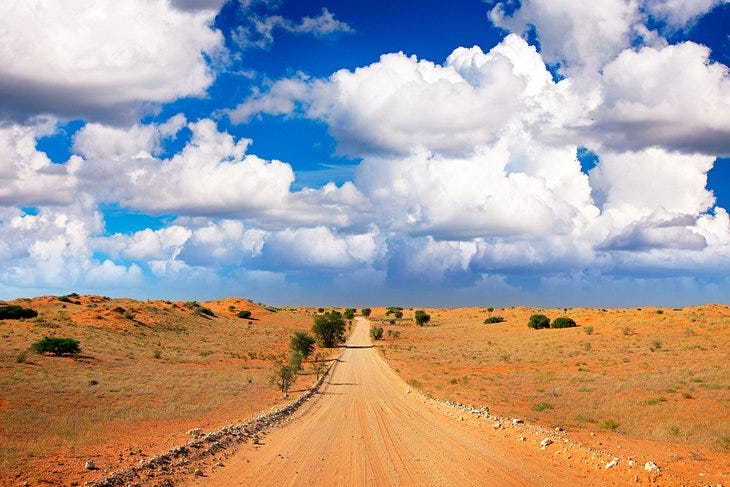
The signage is often confusing, as well; for a while, I follow an arrow on a sign which seems to point towards the continuation of the road I want, but it actually steers me directly into a filthy, poverty-ravaged township. (When the road turned into dirt, I decide I must have misunderstood the where that arrow indicated that I go; I promptly whip a “U-ie” (as they call such a maneuver around here) and find, after returning to the spot of the mistake, that the place I needed to turn was just after the road I’d mistakenly taken.
Hopping onto the N-12 outside of Jo’burg, I then pass through Potchefstroom, then proceed south through Warrenton and Kimberley, in whose dingy city center I temporarily lose the trail again. I have to turn several more U-ies before I regain sight of the N-12; once again, I have been thrown off by ambiguous signage in the midst of a dizzying series of twilit intersections. I pause to purchase a “Zinger Burger” from a roadside KFC (the most popular American fast food chain in this country), and once more head south towards Hopetown.
Hitting this lonely stretch in the gathering dusk, I soon find myself utterly in the dark for a good couple of hours. Here in the karoo, the semi-desert terrain of the Northern Cape, towns are scarce, and this once major highway has essentially become a ragged country road. I grip the wheel, put my brights on when possible, and remind myself to “stay to the left, stay to the left, stay to the left.” Occasionally trucks pass from the other direction with a zoom and a whoosh, and I briefly hyperventilate at the friction of what seems to be a near-sideswipe. Finally, at Hopetown I turn left on N-396 and in forty kilometers, at 10 p.m. I arrive in Orania, where it appears the entire town has gone to bed.
John Strydom, the kindly if insistently industrious public relations officer of the town, escorts me through the rows of charmingly austere little houses and up a small hill, to where my accommodations have been prepared in a row of rooms still largely under construction. The wind whips madly through the lonely brush as I grab my suitcase and stagger into my spare but clean little suite, overtired and a bit grumpy and frazzled from the arduous trek I’ve just completed. Unlike the original Voortrekkers, I haven’t had to ride in a creaky ox wagon or fight off Zulu impis, but I still feel worn out and down for the count. I sleep well into the morning, but a buzzsaw from a nearby construction site provides a jarring wakeup call.
ORANIA
For the next three days, I explore Orania, talk with its residents and representatives, and take in the sights and sounds. Having arrived with no consciously preconceived notions, I find myself surprised just the same. It seems, in many ways, a very ordinary country town: clean, safe, possibly even a little bit dull.
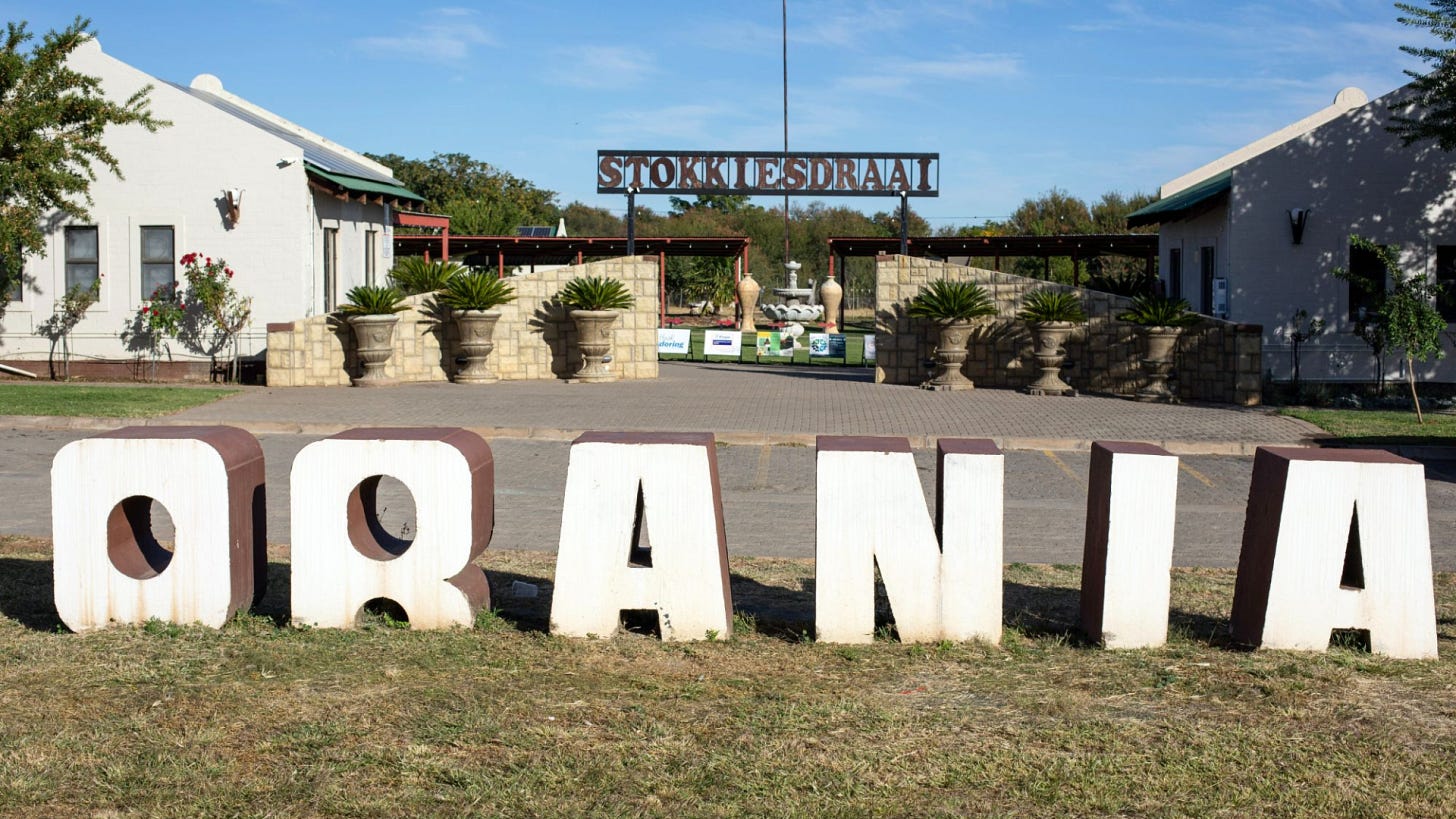
Indeed, those seeking evidence of a weirdly sinister right-wing neo-Nazi cult in Orania are sure to emerge disappointed. I find the place fairly well bursting with friendliness and pleasant vibes. One is struck, in fact, by just how normal these people seem. They aren’t “freakishly” normal, in a 1950s Leave It to Beaver kind of way; they don’t look like they’ve emerged from any sort of a time warp or temporal anomaly out of a Twilight Zone episode; they don’t dress in ostentatious Victorian garb like characters in M. Night Shyamalan’s The Village, nor are they clad in unflattering prairie dresses and long patriarchal beards like dwellers of some unsavory polygamous settlement in the heart of rural Utah.
Instead, the Oranians wear contemporary clothes, sport modern hairstyles, listen to rock music and watch Hollywood movies. At the same time, they also seem focused on remaining apart from the larger society—indeed, it may be said that they practice a kind of voluntary “apartheid,” dedicated to “separate development” of a sort. Moreover, nearly all Oranians seem to be quite religiously observant, though not all belong to the same church. Many are Dutch Reformed, the historical Calvinistic faith of the Afrikaner nation; others are members of the Nederduisch Hervormede Church or the Gereformeerde Church, the more traditional-minded and austere versions of the DRC; still others are members of various conservative “house churches.”
But whichever church body they call home, the Oranians agree to disagree on certain matters of theological doctrine and pull together around issues they view as crucial to their contemporary survival. And they feel that they can only ensure their survival and the continuance of their beloved traditions if they unite around a common vision of the polity, one that lays emphasis on both culture and ethnicity.
There is much gloom and doom among Afrikaners today regarding their prospects for the future, but the architects of the Orania project seem to grasp instinctively that a message of grim, militant pessimism doesn’t sell well. The Orania campaign, thus, is to accentuate the positive. Posters around the town sing of Orania as a “dream come true.” The most prominent promotional photograph depicts five pretty, long-legged young girls, each clad in orange, leaping joyously into the air, alongside the perky proclamation “Welcome To Orania!”
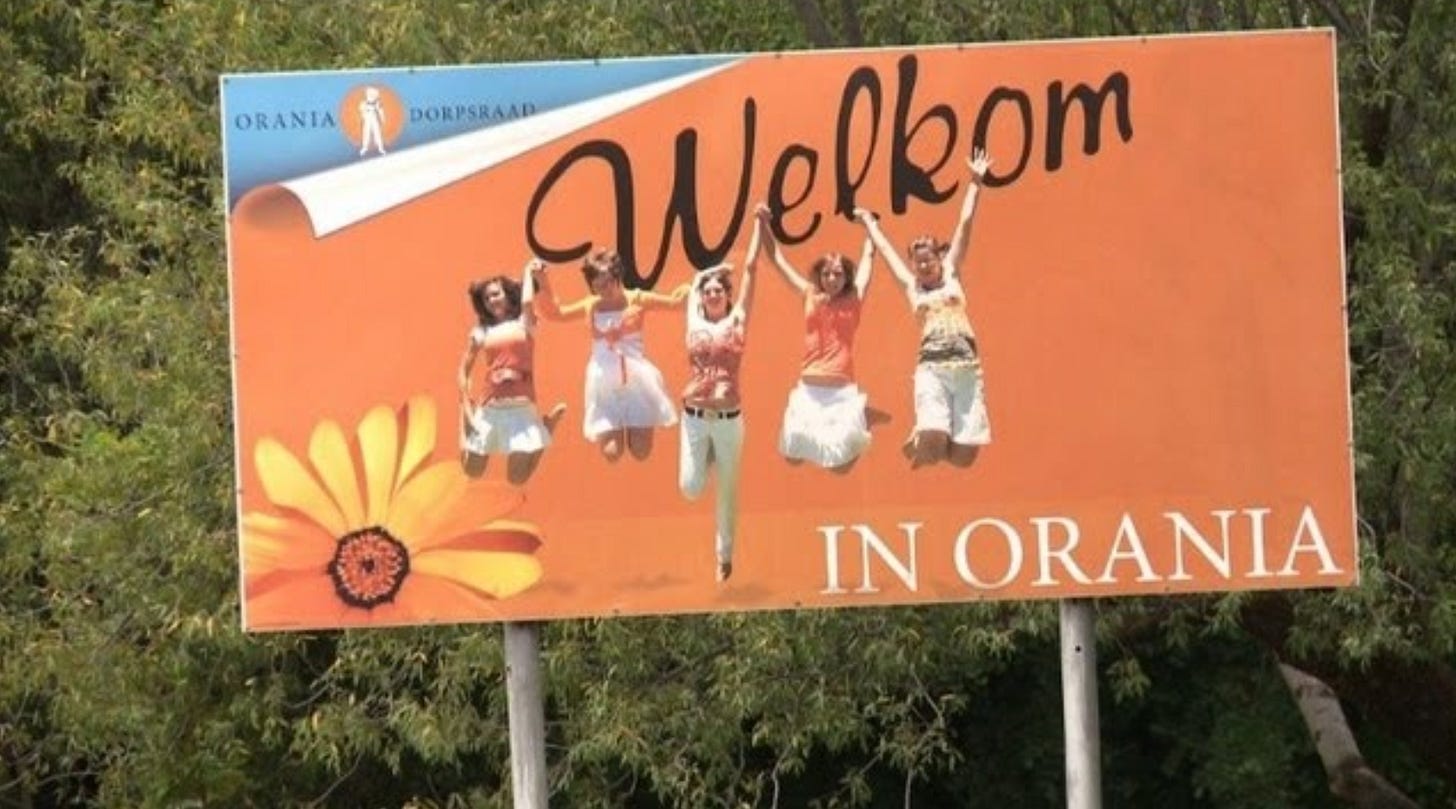
The poster communicates youthfulness, vitality, innocence, even a kind of subtle (if wholesome) sex appeal. It causes the viewer to consider the town, not as a bitter refuge-spot for dead-enders, but as a fun place, where one can live free from care and dwell happily with one’s brethren, and maybe meet a potential wife or husband. And the pitch seems to be working: many do come to Orania, if only to stay temporarily. In addition to its export business of crops and commodities, around 30 percent of Orania’s draw comes from the tourist industry. There is a fancy spa and a chalet-style motel, and an upscale restaurant overlooking the Orange River, along with a camping site. Guests commonly spend a night or two in the middle of a trip to or from Cape Town to relax and recharge. Thus, news of the existence and mission of Orania continues to spread via word of mouth.
The overwhelming majority of the people I meet in Orania prove to be welcoming and warmly accommodating. The fact that I’m an outsider (“uitlander”), that I don’t speak the language, and that I’m there in the capacity of a journalist would all seem to be strikes against me. Orania has seen its share of newspaper and magazine writers over the course of its 20 year existence, and needless to say, most reporters have been of the “smirking liberal” variety—the type who are friendly and sympathetic to your face, take advantage of your sincerely offered hospitality, then proceed to write cruelly nasty articles about you. Despite the fact that the Oranians have no real reason to trust me, most are open with their thoughts, and only a rare specimen here or there seems in any way suspicious of my motives.
SEBASTIAAN OF ORANIA
Perhaps the most interesting person I speak with during my stay in Orania is a shy, retiring, rigorously intellectual 36-year old man named Sebastiaan Biehl. One would normally expect a man of his cerebral bent to be found in academia; in Orania, however, he works as a real estate agent. Biehl is an “uitlander” who, one might say, has gone native. He is from Germany, but he has found his calling, to dwell among the Afrikaners—one might even say he is an Afrikaner convert of sorts.
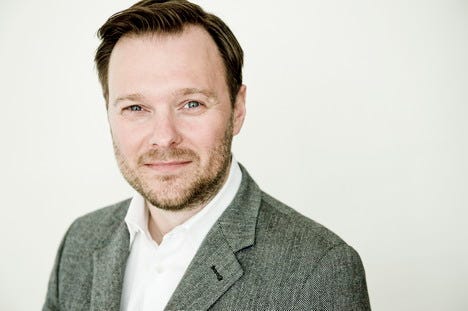
When I ask to confirm that he is German, he answers, “Yes, I was, originally.” But he now considers himself a thoroughly naturalized Afrikaner; he speaks Afrikaans as a first language, and has even published a novel, entitled Beslissing In Die Karoo, in Afrikaans. Biehl’s journey began two decades ago, when he began to correspond with a pen pal who lived on a farm in the Free State province. When he visited in the summer of 1992, he said, it had the effect of a “revelation.” Indeed, after working on his friend’s farm for a couple of months, he had the sensation of finally having found his place in the world.
“I felt like I had come home,” he recalls.
As a solitary, thoughtful lad, Biehl had long felt alienated from contemporary European mores. The erosion of faith in an increasingly secularized society had led, in his observation, to a culture that had grown “cold and immoral,” rife with social ills. Among the Afrikaners, Biehl says, he discovered “a deep-seated conservatism of the hearty sort,” and at the same time he experienced “a rebirth or a rejuvenation of faith.” When he returned to the country of his birth, he came to perceive ever more clearly that he didn’t belong there.
“I saw Germany with new eyes,” he recalls. “I found it superficial and materialistic and hectic and… godless. I couldn’t wait to get back to South Africa again. There was a feeling of freedom there, of wide open spaces. It was like stepping back in time.”
He went to college at South Africa’s Free State University in 1996, earning a degree in Political Science with a focus on History and Politics. Along the way, he changed his first name, adding an additional “a” to his given name of “Sebastian,” in the Afrikaner style. After college, Biehl settled in Bloemfontein, and then in 2005, after much soul searching, he opted to take up residence in Orania. He took a job as a realtor, though it had little relevance to his collegiate training, because he wished to choose a profession in which he could help his adopted hometown to grow and expand.
Biehl says he has absolutely no regrets about his radical lifestyle makeover. Though certain traits still mark him as an “uitlander”—he is, for example, a Lutheran in a community of Calvinists—he couldn’t be happier than to dwell exactly where he does. “Orania will always be where my roots are,” he says. “You have to pay a price if you want to be free.”
https://andynowicki.substack.com/p/afrikaners-seek-a-new-homeland
